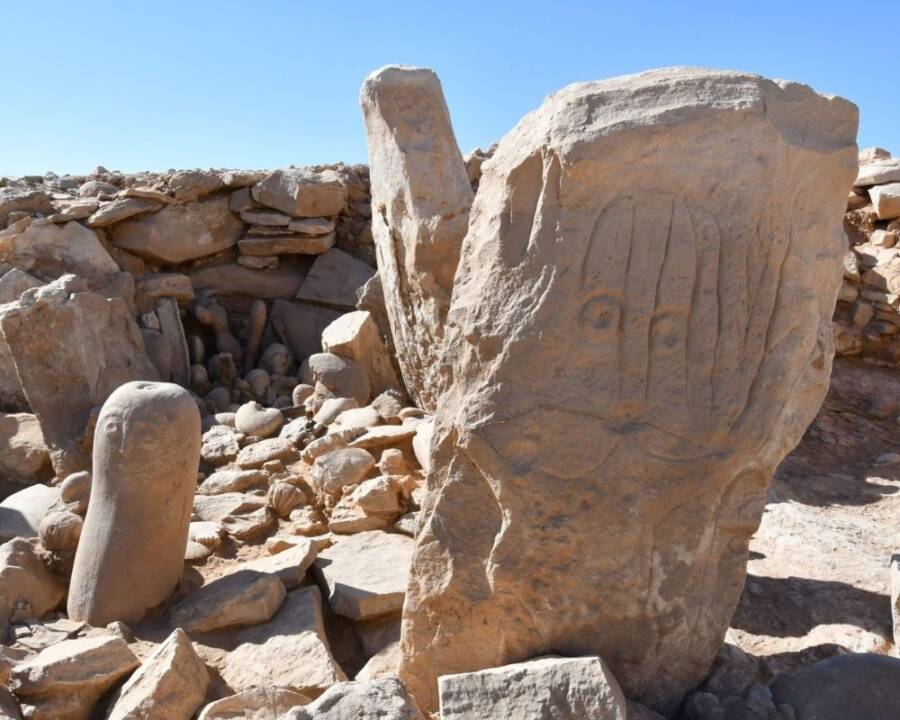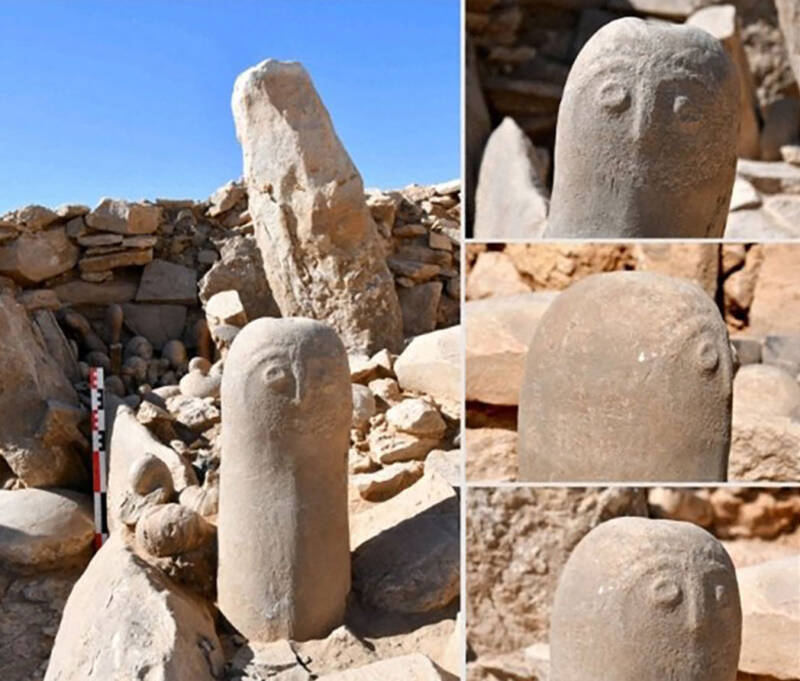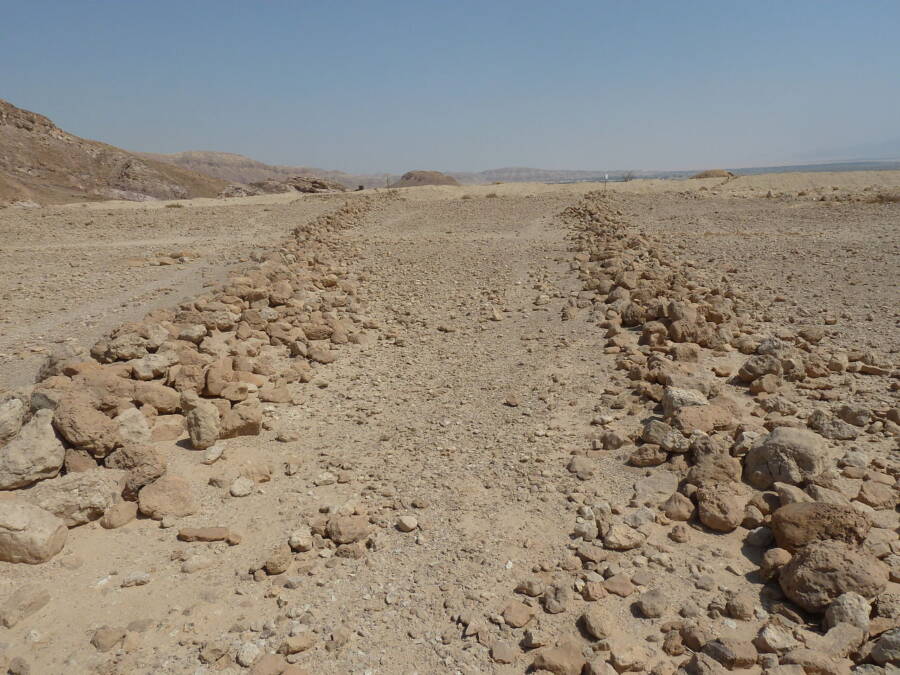The shrine is located near a Neolithic campsite used by hunters during gazelle migration seasons.

Jordan Tourism MinistryArchaeologists found two anthropomorphic stone figures within the shrine.
Deep in the Jordan desert, a team of Jordanian and French archaeologists from the South Eastern Badia Archaeological Project (SEBAP) have uncovered a “unique” and “almost intact” Neolithic shrine. They believe that it’s about 9,000 years old.
“The site is unique, first because of its preservation state,” explained Jordanian archaeologist Wael Abu-Azizeh, the co-director of the project. “It’s 9,000 years old and everything was almost intact.” The shrine was found within a larger campsite.
Archaeologists from Jordan’s Al Hussein Bin Talal University and the French Institute of the Near East came across the site in 2021, while searching a desert plateau in southeastern Jordan. There, according to a statement from the Jordan News Agency, they found two large stones carved with human figures as well as “marine fossils, dolls of animals, exceptional flint tools, and [hearths] associated with the practice of religious rituals.”
The shrine is made up of more than 150 snail-shaped marine fossils next to what would have been an altar. According to Mohammad Tarawneh, another archaeologist on the team, “They were arranged vertically and very carefully in a certain direction.”
The archaeologists working on the project extolled the unique nature of the site:
“This discovery is unprecedented, as it constitutes a unique testimony of a complex ritual arrangement, dating back to the Neolithic period,” they said. “Every single component in itself is remarkable.”
The site was discovered near “desert kites,” or traps used by ancient people to trap wild gazelles, which the archaeological team first came across in 2013. These traps, made of long stone walls leading into an enclosure, appear across the Middle East. Archaeologists also found numerous gazelle bones near the camp.
But the most fascinating part of the discovery is assuredly the two carved stones, which archaeologists dubbed “Ghassan” and “Abu Ghassan.”
“Large standing anthropomorphic steles (stone slabs) are not so common in the Near Eastern Neolithic, and the newly discovered testimonies provide an additional rare example of some of the oldest artistic expression in the Middle East,” archaeologists said.

South Eastern Badia Archaeological ProjectThe shrine likely dates back to 7000 B.C.E.
The larger stone, which is a little over three-and-a-half feet tall, bears the carving of a human figure and a desert kite. The smaller stone, which stands about two feet tall, is inscribed with a human face. As humans were not yet using metal tools at the time, it is likely the statues were carved using flint or other stones.
But what did ancient people use these shrines for? The archaeological team suspects that they played a primarily spiritual role — and reflected the importance of the desert kites. Hunting gazelle, they suggested, must have been the “center of [Neolithic people’s] cultural, economic, and even symbolic life.”
In their statement, the researchers explained: “The sacral symbolism and ritual performance evidenced were most likely devoted to invoke the supernatural forces for successful hunts and abundance of preys to capture.”
“The altar and associated hearth suggest that some kind of sacrificial offerings must have been involved in the ritual process.”
Both Jordanian and French representatives are thrilled at the discovery, which they note is “the only architectural model of its kind known to date worldwide in a Neolithic context.”

Galpaz/Wikimedia CommonsThe remnants of an ancient desert kite. These elaborate gazelle traps played an important cultural and spiritual role for Neolithic civilizations.
“Jordan is the cradle of civilizations that has embraced and continues to amaze us with what comes out of its womb and its pure soil from new archaeological discoveries, not only at the local level but also at the international level,” raved Jordanian Minister of Tourism and Antiquities Nayef Hamidi Al-Fayez in his announcement of the discovery.
And French ambassador Veronique Vouland-Aneini praised the discovery, saying, “It provides us with a priceless testimony of the historical life in the Middle East, its traditions and rituals.”
This archaeological project is part of a decade-long quest to understand “the first pastoral nomadic societies, as well as the evolution of specialized subsistence strategies.”
Happily, it seems that the discovery of this Neolithic shrine will offer an important piece of that larger puzzle. It also goes to show that the Jordanian desert contains plenty of stories about our shared human past.
After reading about the Neolithic shrine found in the Jordanian desert, learn about some other fascinating discoveries from humanity’s past, like the 1,500-year-old wine factory in Yavne, Israel, or the 10,000-year-old woolly mammoth remains found in Siberia’s Pechevalavato Lake.





